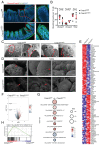Executioner caspases 3 and 7 are dispensable for intestinal epithelium turnover and homeostasis at steady state
- PMID: 35105800
- PMCID: PMC8832966
- DOI: 10.1073/pnas.2024508119
Executioner caspases 3 and 7 are dispensable for intestinal epithelium turnover and homeostasis at steady state
Abstract
Apoptosis is widely believed to be crucial for epithelial cell death and shedding in the intestine, thereby shaping the overall architecture of the gastrointestinal tract, but also regulating tolerance induction, pinpointing a role of apoptosis intestinal epithelial cell (IEC) turnover and maintenance of barrier function, and in maintaining immune homeostasis. To experimentally address this concept, we generated IEC-specific knockout mice that lack both executioner caspase-3 and caspase-7 (Casp3/7ΔIEC), which are the converging point of the extrinsic and intrinsic apoptotic pathway. Surprisingly, the overall architecture, cellular landscape, and proliferation rate remained unchanged in these mice. However, nonapoptotic cell extrusion was increased in Casp3/7ΔIEC mice, compensating apoptosis deficiency, maintaining the same physiological level of IEC shedding. Microbiome richness and composition stayed unaffected, bearing no sign of dysbiosis. Transcriptome and single-cell RNA sequencing analyses of IECs and immune cells revealed no differences in signaling pathways of differentiation and inflammation. These findings demonstrate that during homeostasis, apoptosis per se is dispensable for IEC turnover at the top of intestinal villi intestinal tissue dynamics, microbiome, and immune cell composition.
Keywords: apoptosis; caspases; cell death; mucosal immunology; regeneration.
Copyright © 2022 the Author(s). Published by PNAS.
Conflict of interest statement
The authors declare no competing interest.
Figures




References
-
- Peterson L. W., Artis D., Intestinal epithelial cells: Regulators of barrier function and immune homeostasis. Nat. Rev. Immunol. 14, 141–153 (2014). - PubMed
-
- Beumer J., Clevers H., Cell fate specification and differentiation in the adult mammalian intestine. Nat. Rev. Mol. Cell Biol. 22, 39–53 (2021). - PubMed
-
- Beumer J., Clevers H., Regulation and plasticity of intestinal stem cells during homeostasis and regeneration. Development 143, 3639–3649 (2016). - PubMed
-
- Nagata S., Apoptosis and autoimmune diseases. Ann. N. Y. Acad. Sci. 1209, 10–16 (2010). - PubMed
Publication types
MeSH terms
Substances
LinkOut - more resources
Full Text Sources
Molecular Biology Databases
Research Materials

